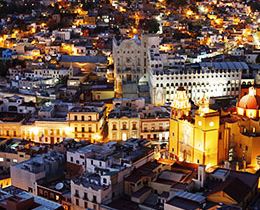Urban Energy Efficiency Key to Mexico’s Ambitious Goals for Energy and Low Carbon Growth
- Mexico sees urban energy efficiency as critical for sustainable growth, livable cities and competitiveness
- Ministry of Energy rolls out national municipal urban energy efficiency program with World Bank support
- National program to include diagnostics of energy use in 30 cities across the country, including Guadalajara and Monterrey
 Mexico’s urbanization is gaining steam. By 2027, city dwellers are projected to make up 88 percent of the population. At the same time, Mexico faces the possibility of becoming a net importer of energy by 2020; this would be a shift for a country whose energy sector has traditionally driven growth and competitiveness. To grow sustainably while meeting the needs of these expanding urban populations, Mexico needs to de-couple energy consumption from economic growth.
Mexico’s urbanization is gaining steam. By 2027, city dwellers are projected to make up 88 percent of the population. At the same time, Mexico faces the possibility of becoming a net importer of energy by 2020; this would be a shift for a country whose energy sector has traditionally driven growth and competitiveness. To grow sustainably while meeting the needs of these expanding urban populations, Mexico needs to de-couple energy consumption from economic growth.
In short, Mexico’s cities will have to become much more energy efficient.
Governments at the federal, state and city levels are paying increased attention to this issue, but action to improve the efficiency of city systems and services is often still hampered by institutional barriers and a lack of awareness among local officials.
To address this, SENER, Mexico’s Ministry of Energy, is rolling out a national municipal energy efficiency program with the help of the World Bank. The program will work with city institutions to systematically integrate energy efficiency into policymaking, investment decisions, and procurement at the local level.
“The urban energy diagnostic will allow us to assess for the first time at a national level how energy is used in Mexican cities. The objective is to work with municipalities to design appropriate investments targeted at sectors with the greatest potential for improved energy efficiency.”
– Leonardo Beltran, Deputy Secretary for Energy Planning at SENER
As a first step, SENER is launching diagnostics of energy use in 30 Mexican cities, including the state capitals Guadalajara, Monterrey and Oaxaca. The diagnostics will lay the groundwork for energy efficiency investments in public lighting, municipal buildings, and water and wastewater pumping, among others.
The Mexican government’s increased commitment in this area was on display at a conference on “Energy Efficiency in Cities,” held in Mexico City on June 17-18, where the national municipal energy efficiency program was highlighted to over 200 participants from a dozen countries. The conference was supported in part by the World Bank’s Energy Sector Management Assistance Program (ESMAP), along with other agencies.
“The urban energy diagnostic will allow us to assess for the first time at a national level how energy is used in Mexican cities,” said Leonardo Beltran, Deputy Secretary for Energy Planning at SENER. “The objective is to work with municipalities to design appropriate investments targeted at sectors with the greatest potential for improved energy efficiency.”
The diagnostic studies will also increase the capacity of city officials to conduct energy efficiency assessments, and raise awareness about the substantial gains – in terms of budget savings, improved services with social benefits, and lower carbon emissions – that can result from lower energy expenditures.
The diagnostics will build on the assessments in the cities of León and Puebla using the Tool for Rapid Assessment of City Energy (TRACE). Developed by ESMAP, TRACE is a decision-support system designed to help cities quickly identify and prioritize energy efficiency opportunities.
“We of course knew energy was a major expense for our city, but going through the diagnostic exercise helped us see how important it was to take energy considerations into account as we make investment decisions,” said Fidel García, Director General of Sustainable Development for the Municipality of León. “The TRACE tool identified street lighting, municipal buildings and solid waste as priority areas to address first. In addition, the process helped identify the local institutions that have the capacity to develop a strategic approach for the targeted sectors.”
The potential savings of energy efficiency efforts in urban sectors can be substantial.
For example, in Rio de Janeiro, the World Bank’s assessment showed that a $190 million investment in switching public lighting over to LEDs would not only save the city $380 million in operating costs, it could also reduce energy consumption in the sector by 57 percent. In Mexico, the rapid assessments conducted with TRACE indicated potential energy savings in public lighting of $2.3 million in León and $3.2 million in Puebla.
A recent ESMAP report showed that just a few simple efficiency measures by water and wastewater utilities in developing countries could substantially reduce costs and water losses, realize energy savings of up to 30 percent, and increase access to water for poor communities.
“Energy efficiency can offer practical solutions for budget‐constrained cities to expand and improve their services, boost their competitiveness, reduce their emissions and move to a low carbon development path,” said Malcolm Cosgrove-Davies, Energy Sector Manager for the World Bank’s Latin America and Caribbean Region.
You may have an interest in also reading…
IFC’s Blended Finance Department: Blending Public and Private Finance to Invest in Challenging Markets
What can be done to encourage more private investment in developing countries, especially the poorest and most fragile? This question
Paolo Sironi, IBM: 2022 Global Outlook for Banking and Financial Markets
In the third year of a global pandemic, the financial services industry appears to be acclimating to a new reality.
World Bank on Sustainable Recovery: The Need for Long-Term Financing
The COVID-19 pandemic is affecting every country’s health system and economy to a degree not seen for a century or


















































































